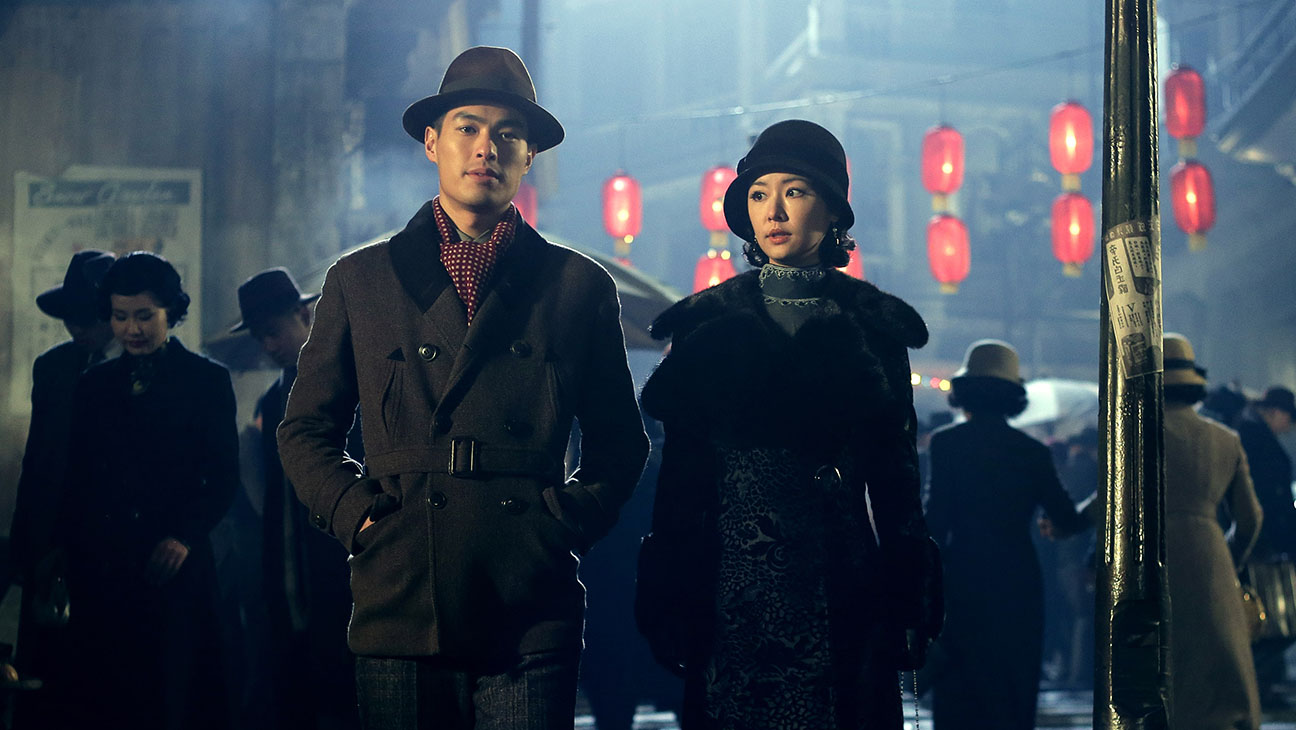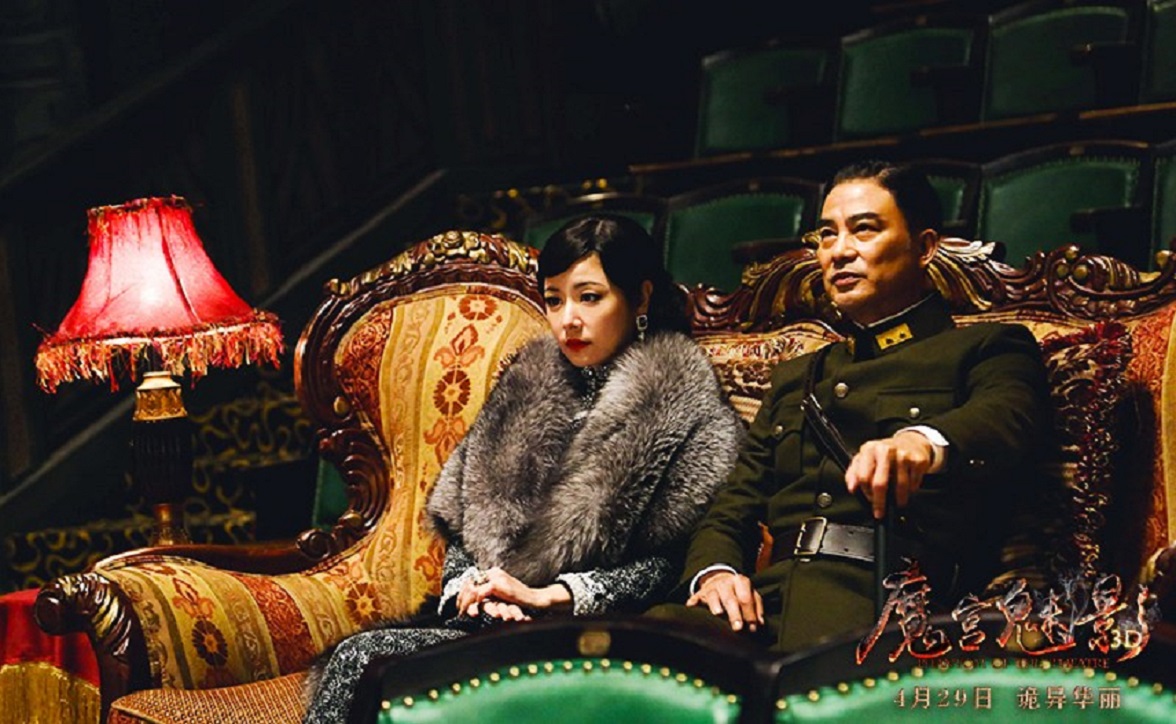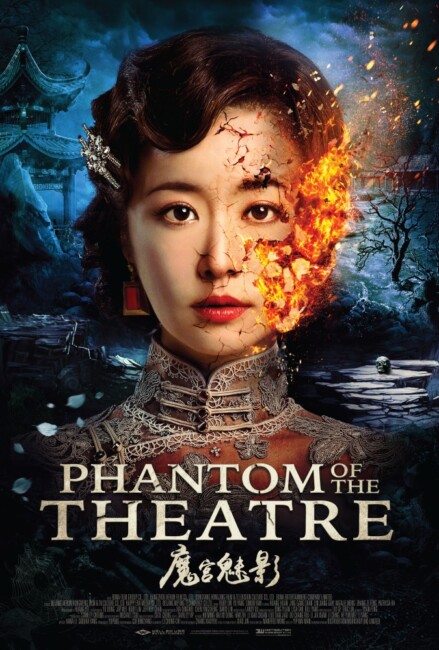(Mo Gong Mei Ying)
Crew
Director – Yip Wai Man, Action Director – Li Chung-chi, Screenplay – Hana Li, Manfred Wong & Sakura Yang, Producer – Manfred Wong, Photography (3D) – Michael Tsui, Music – Yu Peng, Visual Effects Supervisor – Cecil Cheng, Visual Effects – Shanghai Creasun Media Culture Co., Ltd., Makeup Effects Director – Xiao Jin, Art Direction – Yuan Feng. Production Company – Bona Film Group Co., Ltd./Hangzhou Herun Film Co., Ltd./Dongyang Hongjing Film & Television Culture Co., Ltd/Bona Entertainment Company Limited/Beijing Herun Hongmeng Film & TV Culture Co,. Ltd./Happy Era Media Co., Ltd./Beijing Weying Technology Co. Ltd.
Cast
Ruby Lin (Meng Sifan/Kong Jin/Kong Lan), Yo Yang (Gu Weibang), Simon Yam (Gu Mingshan), Huang Huan (Fei Lisi), Jing Gangshan (Kong Shen), Lin Jiangguo (Teng Shirao), Natalie Meng (Pan Ruyu), Wu Xiudong (Liu Kang), Hu Ming (The Adjutant), Huang Lei (Theatre Owner)
Plot
The 1930s. In a poll for the best actress in China, newcomer Meng Sifan trumps the winner by being named the Most Photogenic. Gu Weibang has returned from France and determines that Sifan will be the lead in his film. She agrees after he rescues her from wealthy would-be seducer Teng Shirao by claiming to be her boyfriend. Weibang finds the perfect location in an old abandoned theatre, which everybody claims is haunted. As they begin shooting, the production is plagued by a series of deaths where people spontaneously burst into flame. Many of the crew flee, believing the theatre haunted. Weibang is forced to take the lead after the actor is killed by one of the spontaneous combustions. He and Sifan develop an attraction to one another. However, Weibang’s father, the warlord Gu Mingshan, comes and steals Sifan away from his arms and announces their engagement. What he does not know is that Sifan is in cahoots with the hideously disfigured Phantom that lurks in the theatre and that they have planned an elaborate revenge against Mingshan.
Phantom of the Theatre is the novelty of a Chinese-made version of Gaston Leroux’s The Phantom of the Opera (1909). Ever since its first appearance on screens back with Lon Chaney [Sr] in The Phantom of the Opera (1925), the public has had a fascination with the story, which has led to multiple interpretations and a hit stage musical in 1986 that turned the story into a weepy romantic one. (See below for other versions of the The Phantom of the Opera).
China has become a major player in world cinema in the 2010s. Having just started to realise the size of their domestic box-office, they have been conducting a series of sumptuous productions – ones clearly intended for a world audience (the version I saw here came with the credits printed in both English and Mandarin). This is evident in the lavishness devoted to the production design – the titular theatre becomes a warren of shadowy corners and ornate bric-a-brac that Yip Mai Man’s 3D camera takes a delight in wandering through and showing in great detail.

On the other hand, The Phantom of the Opera has been so thrown on its head that the film leaves you scratching your head trying to find anything recognisable about it. The story of Phantom has been transplanted from a 19th Century opera house to a film being shot in abandoned movie theatre in the 1930s – a perfectly acceptable change, one that was also conducted in The Phantom of Hollywood (1974), which moved the story to a modern movie soundstage.
But then there’s the story. If Phantom of the Theatre was a direct version of The Phantom of the Opera it would be one where the romance at the heart of the story is between the equivalent of Raoul de Chagny and Christine. (In fact, there is no romance between her and the Phantom as, due to a set of plotting complications, [PLOT SPOILERS] she is actually the Phantom’s daughter). In this version, The Phantom is a relatively peripheral character. He is facially disfigured and wears a mask but much of the plotting in the second half involves he and the equivalent of Christine engaged in an elaborate scam to take revenge against the equivalent of Raoul’s father, a warlord who was responsible for his disfigurement in the first place. Thus Phantom has now been contorted into not a romance but an elaborate revenge scheme that has almost nothing to do with the original story.
I felt disappointed with Phantom of the Theatre. I wanted to like it but it resembles The Phantom of the Opera so little that one keeps wondering why they did not call it something different. The other disappointing aspect of Phantom of the Theatre is that it starts out with some sensational and eye-grabbing scenes – ones with romantic rivals spontaneously combusting; elaborate scenes with Ruby Lin being drawn inside mirrors and the sheets of her own bed; even ghosts of the dead appearing out of urns and mirrors in the theatre – that make for a far more fantastical telling than any other version of Phantom to date. The disappointment of the film is that these elements are gradually whittled down to a mundane telling – the spontaneous combustions are explained away as a drug administered by the Phantom, while no explanation is ever given for the ghosts.

One of the oddities of the film is that it also stands still at one point to give a recitation from the handbook by China’s Ministry of Cultural Affairs as to what is accepted in Chinese cinema about the depiction of ghosts and having to tow the state line in regard to their not existing.
The other versions of The Phantom of the Opera are:– The Phantom of the Opera (1925), the finest version of all starring Lon Chaney; Phantom of the Opera (1943) starring Claude Rains; Hammer’s The Phantom of the Opera (1962) starring Herbert Lom; Phantom of the Opera (1983), a tv movie starring Maximillian Schell; The Phantom of the Opera (1989), a slasher film starring Robert Englund, which involved time travel and had The Phantom selling his soul to The Devil; The Phantom of the Opera (1990), a quite reasonable tv mini-series starring Charles Dance; Dario Argento’s The Phantom of the Opera (1998) starring Julian Sands; and the big budget version of the musical The Phantom of the Opera (2004) starring Gerard Butler. Other variations on the story are The Phantom of the Paradise (1974), a satirical version that sets the story to rock music; a pornographic version Phantom (1998); Angel of Music (2008) about a modern reporter conducting an investigation into the truth of the story; and modernisations like The Phantom of Hollywood (tv movie, 1974), The Phantom of the Ritz (1988), Phantom of the Mall: Eric’s Revenge (1989) and a Disney Channel children’s tv movie The Phantom of the Megaplex (2000), which had the Phantom haunting respectively a movie studio, a movie theatre, a mall and a cinema multiplex, as well as the low-budget The Phantom of the Opera (2014) where the Phantom’s spirit is disturbed by a reality tv crew; and the story even being given an uncredited relocation to another planet in the Doctor Who episode The Caves of Androzani (1984).
Trailer here

